Hello, fellow lovers of all things green. Attending the NJ Nursery & Landscape Association show in January is always a delight. This year, I especially enjoyed Bruce Crawford’s talk, the Morris County Park Commission’s Manager of Horticulture. He gave a refresher on myths, truths, and the importance of protecting roots, titled Getting to the Root of the Matter with a few new truths I hadn’t known.
The Myth About the Width of Roots
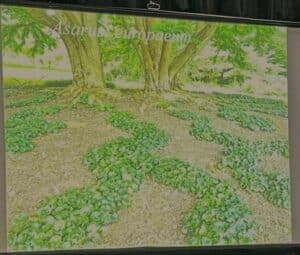
What an artful way to demonstrate root width.
It’s often said that the canopy of a tree, the width of the branches, mimics the width of the roots below, which is not so. They go well beyond that, typically two to four times the width of the branches. And, most of the root activity occurs a few inches below the soil. Hence, the myth that it is okay to park under trees is untrue. It compresses the soil, negatively impacting the roots that most matter to the tree. Once the soil is compacted, it doesn’t go back unless you hire a professional to air-spade to help bring air circulation back to the roots.
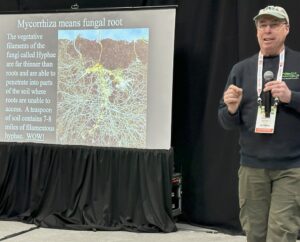
Bruce Crawford, Morris County Park Commission’s Manager of Horticulture
Truths about How Roots Function
Roots of trees are typically 3 feet deep, although they can be far shallower if the soil is insufficient, such as around shale shelves. Their function is to anchor the tree and store food that the foliage and bark produce. Plus, roots produce hormones and absorb and transport nutrients from the soil to the rest of the plant.
Bruce explained that the root plate keeps plants stable and upright. The transport roots, which only move water up tree trunks and shrubs’ stems, form the root plate, combined with the surrounding soil. Ideally, a root plate should be three to six times the trunk’s diameter at four and a half feet above grade to ensure a plant is sure-footed.
Then, there are the small feeder roots. They’re a third of an inch to microscopic and absorb water and nutrients from the soil to feed the tree. They also develop symbiotic relationships with fungi by releasing a hormone, strigolactone.
“These fungi are called mycorrhiza, and over 2500 species of fungi are known to create this relationship,” Bruce shared.
Protecting Roots
During this past summer’s drought, the fungi helped trees survive. Trees want to stay close to other trees because they keep the soil cool and moist, which aids the fungus. Therefore, it’s wise to plant three or four trees in a grouping rather than a solo tree so they help each other. However, they should not be so close that the root plate is compromised.
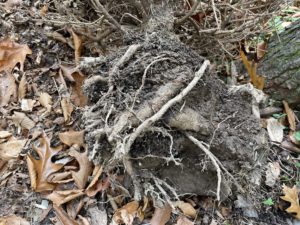
Ellie’s memorial tree was a “bad dig.”
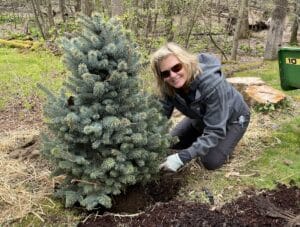
I was glad Bruce brought to the attention of the landscapers in attendance that trees sold as clumps rather than standard (single-stem), such as River Birch, often are not. Some growers group three plants into one pot, which is a problem. As they mature, their root plates can’t support all three trees, and they will split and eventually fall.
Balled and burlap trees, the trade calls B&B, are dug by the grower before being sold to nurseries, who then sell them to us. Eighty percent of roots are cut when digging trees up — many are essential feeder roots, so newly planted trees need extra water for the first three years.
Container-grown plants can also be problematic, as roots can girdle in the pot. To release them, tear the roots apart—I call it tickling roots on small plants—but be more forceful on trees and shrubs.
Truths about Landscape Fabric, Regrading, and Salt Impact on Roots
Landscape fabric folks use, thinking it will help deter weeds, hinder air circulation, and encourage shallow roots. Plus, it doesn’t prevent weeds because weed seeds land in the decomposing mulch and sprout. A side note: Bruce likes using shredded leaves as mulch. That’s my preference, too, especially when they turn into leaf mold, as we discussed in Leaf Mold—Better than Mulch.
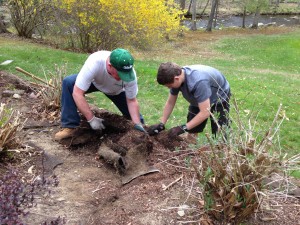
Landscape Fabric Hinders Roots.
It’s the time of year when snow and ice events cause municipalities to salt the roads and parking lots—overly salted, if you ask me. And where does that salt go? It goes into our water systems, our fields, and our gardens. What we can do to help will be a topic for another day.
High salt levels can damage roots by lowering oxygen levels, weakening them, and affecting their ability to absorb water and nutrients. While some people think salt damage is evident on the foliage nearest the road, it’s not always apparent at the base of the plant. The damage often appears elsewhere and may not occur in the first year.
Dispelling the Myth Disturbed Soil Can Sustain Plants.
Another myth is that when we dig up the soil to regrade it to build a house or solve a drainage problem, the disrupted soil can sustain new plants well. That is not the case. It takes years for the soil to recover. So when doing some heavy soil disturbing, add about five to ten inches of topsoil so your new plants will have nutrients to grow. People often cheat on that, and the damage will be evident when the plants are not thriving.
Bruce suggested a cocktail party puzzle: “You can stump guests by asking them how long it takes for nature to restore or create one inch of topsoil.” The answer is five hundred to a thousand years! May we never take for granted how precious our soil and roots are.
Garden Dilemmas? AskMaryStone@gmail.com and your favorite Podcast App.
Enjoy more of the story on the Garden Dilemmas Podcast (11 soothing minutes):
Related Posts and Podcasts you’ll enjoy:
Wonders of Willowwood Arboretum – Blog Post / Episode 161. Wonders of Willowwood with Bruce Crawford
Insights and Interdependence of Trees – Blog Post / Episode 88. Insights and Interdependence of Trees
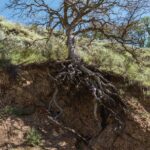
Photo by Jason Leung on Unsplash
A personal note that I hope will resonate with you…
Speaking of roots, I have attributed the loneliness I felt as a child and re-created in my adult life stemmed the origin of my folks, but I think it goes beyond that. My mother’s mom died, giving birth to my mother. And Dad’s Dad split when he was two. So, neither had role models, and both were emotionally distant in their parenting roles. It recently occurred to me that they, too, endured loneliness, loss, and sadness as children, the impact of which they understandably carried into adulthood. It’s a revealing experience to consider how the generations of our past impact us. But I feel blessed to have the parents I had.
Whether yours are biological or adoptive parents, or if the parent role was filled by a relative or friend, understand that it is part of the plan that we are here to experience. The wounds from our past can be released and healed like flowers release petals to encourage another bloom. Find comfort and wisdom in observing how nature teaches us to let go to allow new growth. No matter what our age, our roots can recover. It helps to talk about it with others. Thank you for allowing me to share. I invite you to email me at AskMaryStone@gmail.com.


